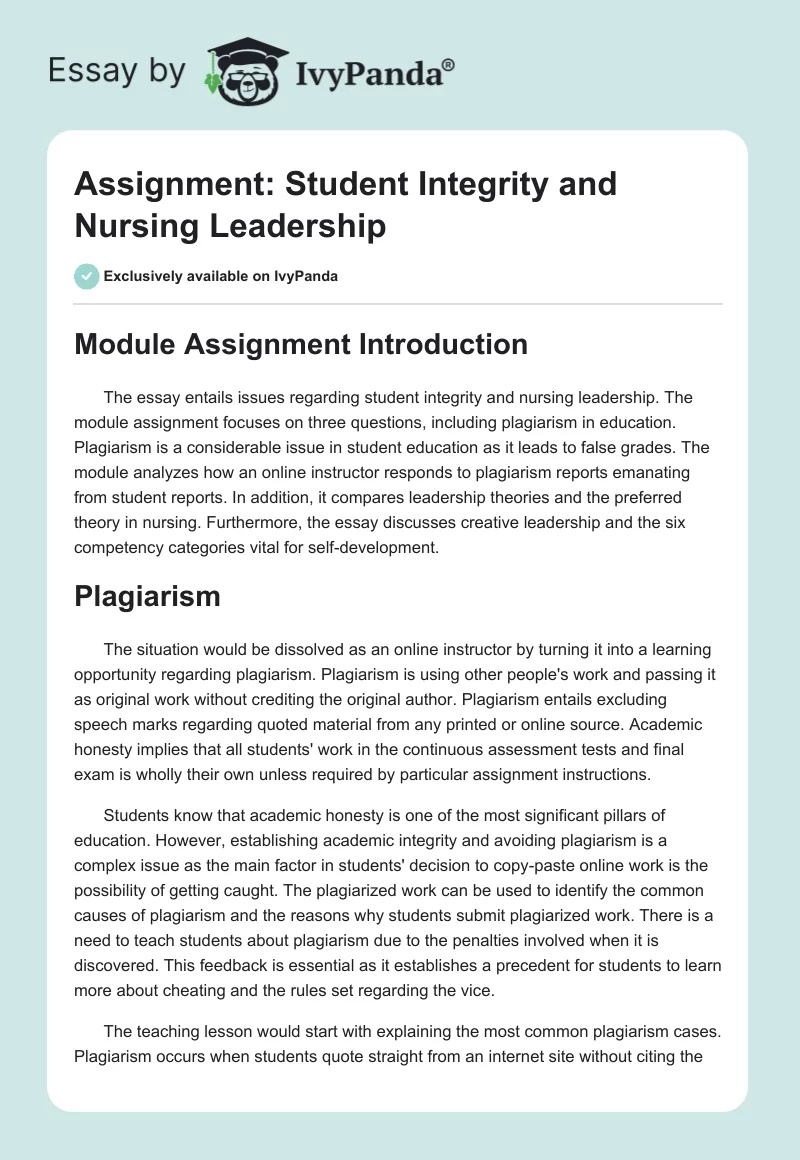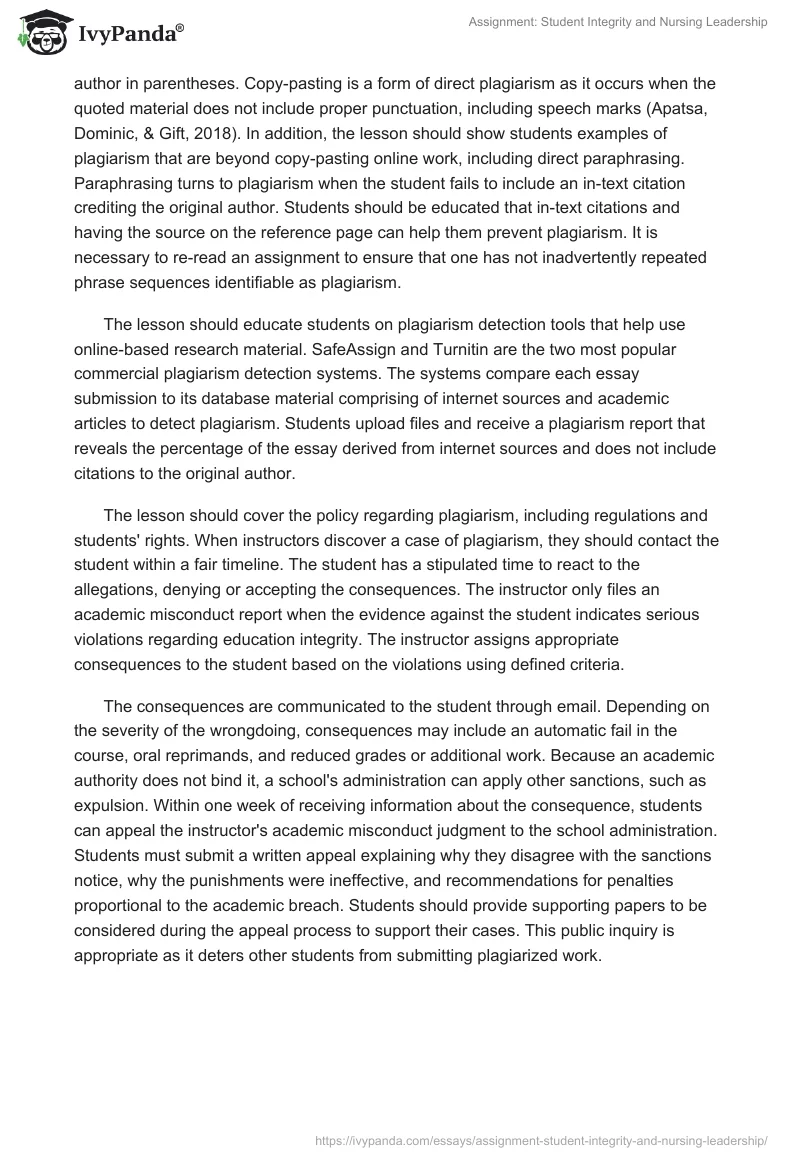Module Assignment Introduction
The essay entails issues regarding student integrity and nursing leadership. The module assignment focuses on three questions, including plagiarism in education. Plagiarism is a considerable issue in student education as it leads to false grades. The module analyzes how an online instructor responds to plagiarism reports emanating from student reports. In addition, it compares leadership theories and the preferred theory in nursing. Furthermore, the essay discusses creative leadership and the six competency categories vital for self-development.
Plagiarism
The situation would be dissolved as an online instructor by turning it into a learning opportunity regarding plagiarism. Plagiarism is using other people’s work and passing it as original work without crediting the original author. Plagiarism entails excluding speech marks regarding quoted material from any printed or online source. Academic honesty implies that all students’ work in the continuous assessment tests and final exam is wholly their own unless required by particular assignment instructions.
Students know that academic honesty is one of the most significant pillars of education. However, establishing academic integrity and avoiding plagiarism is a complex issue as the main factor in students’ decision to copy-paste online work is the possibility of getting caught. The plagiarized work can be used to identify the common causes of plagiarism and the reasons why students submit plagiarized work. There is a need to teach students about plagiarism due to the penalties involved when it is discovered. This feedback is essential as it establishes a precedent for students to learn more about cheating and the rules set regarding the vice.
The teaching lesson would start with explaining the most common plagiarism cases. Plagiarism occurs when students quote straight from an internet site without citing the author in parentheses. Copy-pasting is a form of direct plagiarism as it occurs when the quoted material does not include proper punctuation, including speech marks (Apatsa, Dominic, & Gift, 2018). In addition, the lesson should show students examples of plagiarism that are beyond copy-pasting online work, including direct paraphrasing. Paraphrasing turns to plagiarism when the student fails to include an in-text citation crediting the original author. Students should be educated that in-text citations and having the source on the reference page can help them prevent plagiarism. It is necessary to re-read an assignment to ensure that one has not inadvertently repeated phrase sequences identifiable as plagiarism.
The lesson should educate students on plagiarism detection tools that help use online-based research material. SafeAssign and Turnitin are the two most popular commercial plagiarism detection systems. The systems compare each essay submission to its database material comprising of internet sources and academic articles to detect plagiarism. Students upload files and receive a plagiarism report that reveals the percentage of the essay derived from internet sources and does not include citations to the original author.
The lesson should cover the policy regarding plagiarism, including regulations and students’ rights. When instructors discover a case of plagiarism, they should contact the student within a fair timeline. The student has a stipulated time to react to the allegations, denying or accepting the consequences. The instructor only files an academic misconduct report when the evidence against the student indicates serious violations regarding education integrity. The instructor assigns appropriate consequences to the student based on the violations using defined criteria.
The consequences are communicated to the student through email. Depending on the severity of the wrongdoing, consequences may include an automatic fail in the course, oral reprimands, and reduced grades or additional work. Because an academic authority does not bind it, a school’s administration can apply other sanctions, such as expulsion. Within one week of receiving information about the consequence, students can appeal the instructor’s academic misconduct judgment to the school administration. Students must submit a written appeal explaining why they disagree with the sanctions notice, why the punishments were ineffective, and recommendations for penalties proportional to the academic breach. Students should provide supporting papers to be considered during the appeal process to support their cases. This public inquiry is appropriate as it deters other students from submitting plagiarized work.
Leadership Theory
The strategy for leadership development is centered on transformational leadership. The style provides people with a vision of where the organization is now and where it should be going and then pushes them to unite around the goals outlined. Transformational leadership combines values from democratic, transactional, and laissez-faire leadership styles. Democratic leadership is a style of management in which people have a greater say in how a corporation makes decisions. Employees are allowed to participate, exchange ideas openly, and stimulate discussion.
Furthermore, there is a free flow of ideas as the leader is present to provide control measures if there is an obstacle to project completion. In a transactional leadership style, employees who do their responsibilities to a high degree are rewarded, while those who do not meet the prescribed requirements are punished. A transactional leader operates within the organization’s culture, adhering to the norms and maintaining order in executing duties.
In a laissez-faire leadership style, a supervisor outsources employees’ responsibilities and lets the team decide on techniques to complete a project. Individuals do not require close monitoring since they can resolve challenges and complete work independently. Transformational leadership emphasizes that one must first know oneself before someone can lead. Transformational leadership is not bound by top-down authority and seeks to inspire individuals. There are no inherent hierarchy constraints, as leaders rely on expert advice and motivation as the ultimate source of authority. Transformational leaders’ idealized influence is through informal interaction entailed in the relationship between leaders and subordinates. Nurse leaders employing transformational leadership are open to new ideas based on collaborative efforts where new solutions are adopted regardless of an individual’s position. Collaborative efforts lead to an optimal solution favorable to a team.
Transformational leadership traits entail approaching obstacles to solving the root causes of problems through innovations and creativity. Innovations are vital as they help mitigate problems through detection, turning them into opportunities. Active listening skills allow individuals to input suggestions regarding productivity, thus building trust (Hoch et al., 2018). Transformational leadership derives some of its qualities from the visionary style, such as influencing individuals toward a specific goal. Both visionary and transformational leaders recognize that objectives are attained through connecting team members to an objective. Transformational leaders have a detailed vision regarding where the team is headed to accomplish set goals.
Nurse leaders employ a transformative leadership style due to the numerous benefits accrued, such as a motivated workforce and improved patient outcomes. Nurse leaders’ relationship with subordinates entails understanding the requirements and behaviors of healthcare workers. This means creating a suitable work environment that considers the psychological needs of healthcare workers. Nurse leaders should be visionary and communicate their vision as trustworthy and credible. Furthermore, a clear articulation of long-term goals is required to inspire confidence in future practice.
Leaders should involve healthcare practitioners, as this guarantees that everyone affected by the healthcare demands is involved in the decision-making process (Ayeleke, Dunham, & Wallis, 2018). Leaders can also impact outcomes by adopting a collaborative working style and establishing long-term commitments. This is particularly true in reducing medical errors where lack of collaboration is the most common cause of the issue. Nurse leaders implementing transformational leadership style benefit in various ways, including improved patient care, nurses’ satisfaction, low turnover rate, and improved efficiency, leading to lower costs. The most prominent nurse leader who utilized a transformational leadership style was Florence Nightingale. Nurse leaders have since implemented this leadership style as they strive to improve efficiency in healthcare. Most nurse leaders use a transformational leadership style to balance their supervisor roles between motivation and control. Transformational nurse leaders provide staff tools to make decisions and take charge of situations, thus inspiring the subordinates.
Creative Leadership
A creative leadership position entails developing team members’ skills, resolving conflict, and leading the team towards a defined goal. Problem-solving is one of the greatest attributes I possess. Good leaders are efficient problem solvers and negotiators to the team. Employees will follow leaders when they have assurances that it is in their best interest. The problem-solving tactic entails focusing on employees’ interests and satisfying them without compromising the company’s short and long-term objectives (Rubens et al., 2018). This tactic will involve negotiating agreements that favor both parties, thus creating a positive environment. Emotionally charged conflicts are the most difficult to solve due to employees’ rage. Emotional intelligence in a leader is essential in developing problem-solving skills critical for leadership to succeed. Impulse control in conflict resolution is vital in relationship management, especially in passive-aggressive conflicts.
The first step as a problem solver is actively listening to the parties involved. Active listening is crucial in conflict resolution as first-hand information is to be relied upon. The next step entails self-reflection on the information obtained from the listening session. Self-reflection helps leaders to understand the point of view of each party involved. This encompasses listening to employees while being attentive to their words and viewing the situation from their perceptive. The decision should reflect the company’s vision and mission to lead staff in all aspects. Empathy in conflict resolution is an advantage as its better to build relationships among the employees. The most critical issue to resolve entailed office politics regarding relationships in the workplace. Organizational politics is an inevitable element of the business environment, yet it undermines teamwork. It is prudent to ensure office politics do not interfere with organizational culture; thus, team members need to cooperate within the premises.
The greatest weakness entails collaboration in terms of being patient with employee development. Each staff member has a unique job developmental phase; thus, a leader must be patient regarding job efficiency to sustain workplace morale. The plan to improve my support rate to employees when faced with obstacles entail understanding other people’s experiences and using them to build trust among team members.
In addition, constructive feedback is necessary as it limits rational behavior in the workplace. Asking for feedback and implementing it shows that input by members is valued. Regular feedback improves team spirit and results and thus is a critical factor in facilitating team cohesiveness (Khawam, DiDona, & Hernández, 2017). Being open to team members’ ideas develops trust as leaders know they do not have infinite solutions to organizational issues. It is prudent to invest in conversations by listening to understand the team member’s input. Active listening creates emotional connection as employees have a platform to relay their needs.
References
Apatsa, S., Dominic, C. W., & Gift, D. (2018). Why do postgraduate students commit plagiarism? An empirical study. International Journal for Educational Integrity, 14(1).
Ayeleke, R. O, Dunham, A., & Wallis, N. N. a. (2018). The concept of leadership in the health care sector. In (Ed.), Leadership. Intech Open. Web.
Hoch, J. E., Bommer, W. H., Dulebohn, J. H., & Wu, D. (2018). Do ethical, authentic, and servant leadership explain variance above and beyond transformational leadership? A meta-analysis. Journal of Management, 44(2), 501-529.
Khawam, A. M., DiDona, T., & Hernández, B. S. (2017). Effectiveness of teamwork in the workplace. International Journal of Sciences: Basic and Applied Research (IJSBAR), 32(3), 267-286.
Rubens, A., Schoenfeld, G. A., Schaffer, B. S., & Leah, J. S. (2018). Self-awareness and leadership: Developing an individual strategic professional development plan in an MBA leadership course. The International Journal of Management Education, 16(1), 1-13.


